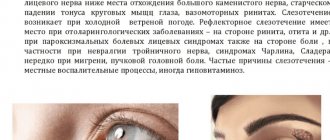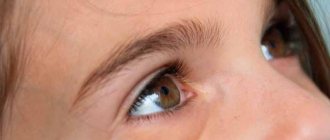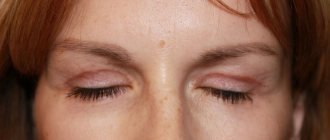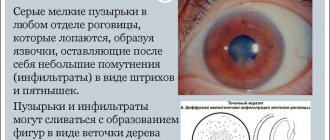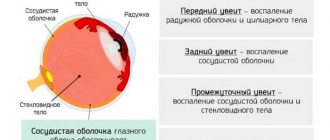Causes
Pain in the eyes may indicate the development of problems with the visual organs. The cause of this condition may be simple fatigue or serious pathology.
A burning sensation in the eyes is one of the symptoms of an inflammatory disease of the organs of vision or injury. Before prescribing treatment, the doctor must determine the cause of the discomfort.
Physical irritation
Often, unpleasant sensations in the eyes occur after prolonged exposure to wind or frost. Physical irritants include bright sunlight and sudden changes in temperature. In this case, the visual apparatus tries to protect the eyes from damage.
Physical irritation occurs when working at a computer or reading for a long time. Incorrectly selected or low-quality lenses can have a negative impact.
Inflammatory diseases
Pain in the eyes can be a symptom of an inflammatory process. This symptom is characteristic of keratitis and conjunctivitis. At the same time, redness of the eyelids and the production of tears are observed. Purulent discharge is not always present.
IMPORTANT. This pathological condition occurs as a result of infection by bacteria, viruses or dangerous fungi.
A feeling of pain accompanies the following ophthalmological diseases:
- Blepharitis . This is inflammation of the edges of the eyelids. The patient experiences eyelid redness and itching. This disease often occurs due to incorrectly selected glasses, damage to the gastrointestinal tract or vitamin deficiency.
- Conjunctivitis . One of the most common diseases that occurs as a result of infection with a virus, bacteria or chlamydia. The infection can get into the eyes through dirty hands or severe hypothermia. Allergic conjunctivitis occurs due to sensitivity to the components of the drug. Treatment is prescribed depending on the causative agent of the pathological process.
- Keratitis. With this disease, inflammation of the cornea of the eye occurs. It occurs when there is an infection in the body. The patient suffers not only from pain in the eyes, but also from increased lacrimation, photophobia and pain.
- Iritis. This is an inflammation of the iris of the eye. The disease has an acute onset. The patient's vision sharply decreases, pain, photophobia and redness occur. With such a pathological process, the patient is urgently admitted to a hospital for diagnosis and treatment.
Each of the inflammatory diseases has a number of symptoms. To get rid of pain in the eyes, it is necessary to carry out comprehensive treatment of the pathological process.
Injuries
Scratches on the cornea can cause discomfort. There is a pain in the eyes and a sensation of a foreign body under the eyelid.
Damage can be caused by wearing contact lenses for a long time or by getting a foreign body into the eye.
In most cases, scratches are harmless, but they increase light sensitivity, thereby causing discomfort.
Trauma also includes a chemical burn. It occurs when an alkaline or acidic substance gets into the eye. Sometimes burns occur from the intense color. For example, while welding or visiting a solarium.
The degree of eye damage is determined by the doctor after an examination. Severe injuries threaten loss of vision, the patient must be hospitalized immediately.
Why does it always hurt my eyes?
The cause of constant pain in the eyes may be incorrectly selected lenses or wearing them for a long time. If the product is of poor quality, then there is a risk of developing corneal hypoxia, since the lens does not allow sufficient oxygen to pass into the tissue. This condition can become chronic, and this leads to a decrease in visual acuity.
REFERENCE. The patient may experience an allergic reaction to protein components that accumulate on the surface of the lenses or in the solution for storing them. There is also a risk of chemical damage. If the instructions are not followed, the contact lens solution may burn the cornea. Ill-fitting lenses can permanently damage and irritate the surface of the eye.
Cutting in the morning
Pain in the morning may indicate the development of an ophthalmological disease. These may be the following diseases:
- keratitis;
- blepharitis;
- conjunctivitis;
- cyclites;
- glaucoma.
If discomfort persists for a long period of time, you should consult a doctor. He will conduct a diagnosis, determine the cause of the pathological condition and prescribe appropriate treatment.
Eye diseases that can cause pain
The most common diseases that can cause such a phenomenon as sharp stabbing pain in the eye are:
- angle-closure glaucoma, which can cause sharp, unexpected pain in the affected eye;
- open-angle glaucoma is characterized by moderate pain;
- astigmatism, especially when it is impossible to correct it;
- blepharitis, in which the eyelids become inflamed and there is a sensation in which the eyes prick and there is a feeling of a foreign body;
- conjunctivitis may not cause very severe pain, but with this disease the eyes itch and purulent discharge appears, and different forms of this disease cause varying degrees of pain;
- the so-called stye causes an increase in pain as it “ripens”.
Associated symptoms
There are a number of accompanying symptoms. Along with pain in the eyes, the patient may complain of frequent headaches, dry eyes and increased tearing.
Headache
Unpleasant sensations in the organs of vision may be accompanied not only by a headache, but by a constant migraine. In this case, two foci of pain are formed: behind the eye and in the head. The pain can be stabbing, long-lasting and excruciating.
Cause of headaches and pain in the eyes:
- Severe fatigue. Such symptoms are more often observed in people who spend a lot of time watching the computer or TV.
- Incorrectly selected lenses. This leads to the fact that the eyes are under constant tension, and the condition of the optic nerve is constantly deteriorating.
- Nervous overstrain. In this case, there is a spasm of the blood vessels that supply the muscles of the face, neck and shoulders.
These two symptoms are also typical for a simple cold, minor eye injury, or prolonged exposure to the sun or wind.
REFERENCE. In some cases, a headache and a feeling of pain in the organs of vision may indicate the development of cluster cephalgia. Attacks of such a disease are associated with the patient’s biological rhythms. Most often, this deviation is diagnosed in smokers. It can also occur against the background of dilation of blood vessels or problems with the vegetative-vascular system.
Dry eyes
Dry eyes occur when the tear glands no longer produce enough tears to lubricate the eye. As a result, the visual organs become too dry and the nerves of the cornea are irritated. Against the background of these processes, pain and sensitivity arise. This condition is dangerous due to the formation of scratches on the eyes.
Causes of dry eyes:
- Excessive use of gadgets. Bright light forces a person to look very carefully, and he can be so engrossed that the number of blinks is reduced to a minimum.
- Dry air. It dries out the natural tears that bathe the eye.
- Hormonal changes. They are observed in women during menopausal changes in the body.
- Wearing contact lenses. Long-term wearing of such products provokes dry eye syndrome.
- Taking medications. This condition occurs when taking antidepressants and oral contraceptives.
What to do?
If you experience a sensation of pain in your eyes, you should consult a specialist and undergo an examination. If such a feeling occurs quite rarely, then it may indicate simple overexertion and overwork. First of all, it is necessary to reduce eye strain and normalize sleep patterns.
Which specialist should I contact?
If pain in the eyes occurs, you should consult an ophthalmologist. He will prescribe a diagnosis and select further treatment.
Diagnostics
Diagnostics is aimed at finding out the causes of the pathological condition. The following studies and procedures are carried out:
- history taking and examination;
- fundus examination;
- ophthalmoscopy;
- ultrasound diagnostics of the eyes to identify injured structures;
- measurement of intraocular pressure;
- taking scrapings from the eyelids;
- West's test;
- visual field study.
Diagnostic methods directly depend on the suspected disease. Aberrometry is used to determine the presence of optical distortion. Using keratotopography, you can determine the homogeneity or unevenness of the cornea.
Computer perimetry is prescribed if glaucoma is suspected. Confocal microscopy makes it possible to visualize the condition of the tissues of the cornea at the microstructural and cellular level.
Optical coherence tomography is used to diagnose the condition of the optic nerve and retina. This is a painless method that has virtually no contraindications.
If the patient complains of pressing pain, the doctor may prescribe a magnetic resonance imaging scan of the brain or a computed tomography scan. In some cases, an x-ray of the sinuses is performed.
What can't you do?
Self-medication is prohibited. It may worsen the patient's condition. Using medications without a doctor's prescription may result in side effects or an allergic reaction.
Expert opinion
Slonimsky Mikhail Germanovich
Ophthalmologist of the highest qualification category. Has extensive experience in diagnosing and treating eye diseases in adults and children. More than 20 years of experience.
Treatment of serious ophthalmological diseases cannot be carried out only with folk remedies. They can be used as additional therapy with the permission of a specialist.
Eye treatment with folk remedies
In some cases, traditional medicine can help, but do not forget that their effect is temporary, after which you will need to contact a qualified specialist.
If your eyelids stick together, you can apply a compress of finely grated raw potatoes to them.
If there is redness, you can make lotions from cotton cloth soaked in dill juice - apply to the reddened areas for 15-20 minutes. Also, for conjunctivitis, you can apply compresses from an infusion of dry plantain leaves for 20 minutes or wash your eyes with this solution.
Methods to alleviate the condition
There are a large number of methods that will alleviate the patient’s condition with pain in the eyes. The doctor may prescribe medication, the use of folk and homeopathic remedies. The greatest effect is achieved by using ophthalmic ointments and drops.
Medicines
To eliminate pain in the eyes, it is necessary to influence the cause of the pathology. To alleviate the patient's condition, it is recommended to use ointments and drops. The use of any medicine must be agreed with a specialist.
Ointments
The use of ointment is prescribed if the pain occurs against the background of an inflammatory disease. Effective drugs:
- tetracycline ointment;
- Hydrocortisone;
- Demazol.
Tetracycline ointment is used to treat infectious lesions. The active component of the medicine eliminates pain, tearing and redness. The ointment is also used for burns and other injuries to the cornea.
This is a broad-spectrum antibiotic. Its active components suppress protein production in the cells of the causative agent of the pathological condition. Indications for use:
- trachoma;
- blepharitis;
- conjunctivitis.
The medicine should be placed behind the lower eyelid 3-5 times a day. In most cases, the eye ointment is well tolerated. Sometimes there is gastrointestinal upset, nausea, and vomiting. Tetracycline ointment will increase the sensitivity of the skin to sunlight. If signs of hypersensitivity to the drug occur, you should stop using the drug. The doctor must choose a non-tetracycline antibiotic.
No less effective is Hydrocortisone ointment. It relieves inflammation and redness. The medicine is used for allergic eye lesions, inflammatory processes, thermal or chemical burns. Hydrocortisone is recommended for use after surgery on eye tissue.
The active substance in Hydrocortisone is hydrocortisone acetate. Auxiliary components are petroleum jelly and methylparaben. This hormonal drug is prescribed for the treatment of:
- allergic eye lesions;
- inflammatory processes in the organs of vision;
- thermal and chemical burns of the cornea.
The use of Hydrocortisone should be avoided in case of individual intolerance to the components, viral and purulent eye lesions. Contraindications include violation of the integrity of the eye membrane and children under 18 years of age.
Demazol relieves inflammation from the eyelids. Active components help fight itching, pain and swelling. The drug is prescribed for parasitic and bacterial infections.
The medicine is not used if the patient is hypersensitive to the components. This product should be applied to the edges of the lower and upper eyelids using a cotton swab. The duration of treatment is determined individually.
For pain in the eyes and other undesirable manifestations, 1% erythromycin ointment can be prescribed. It must be placed behind the lower eyelid. In case of acute discomfort after sleep, you need to apply a bandage to the eye.
Drops
To eliminate pain and dryness in the eyes, drops are prescribed.
Effective drugs:
- Natural tear. The medicine is used to moisturize the mucous membrane. The therapeutic effect lasts for 1.5 hours. These drops are suitable for patients who wear lenses. The medicine is not used in the presence of hypersensitivity to the components and for the treatment of children.
- Vidisik. Active components moisturize the conjunctiva. Drops are not prescribed to patients under 16 years of age. Pregnant and breastfeeding women should use it with caution. You can drive vehicles or perform work that requires high concentration only 15 minutes after using the medicine. Vidisik is buried in the conjunctival sac. The duration of treatment is from 3 to 5 days.
- Lincontin. The drug will be effective for visual strain. Can be used to prevent dryness and pain in the eyes. The medicine is compatible with all types of contact lenses. Drops should be used several times a day.
- Diklo-F . It is used to treat conjunctivitis of non-infectious origin or after ophthalmic surgery. Drops are not prescribed to patients with hypersensitivity to diclofenac or acetylsalicylic acid. Diklo-F is instilled directly into the conjunctival sac, 1 drop every 6-8 hours. The duration of treatment is from 7 days to two weeks.
- Tuafon. Drops are used when the process of tear fluid production is disrupted. The medicine is used for corneal injuries, cataracts and primary open-angle glaucoma. The active components stimulate the restoration process in the tissues of the eye. Tuafon is not prescribed for patients under 18 years of age or with a predisposition to an allergic reaction.
- Voltaren-ofta. Such drops allow you to normalize photosensitivity. They can be used after eye surgery. The dosage depends on the disease. If used incorrectly, side effects may occur. Itching, blurred vision and irritation of the eyes occur. In rare cases, pinpoint lesions of the cornea are observed. The allergic reaction manifests itself through urticaria, rash and conjunctival hyperemia.
General symptoms
Note! Primary pain in the eyes with accompanying lacrimation may vary in intensity depending on the causes of this phenomenon.
also on the disease whether additional symptoms will appear in the form of:
- redness of the conjunctiva;
- increased light sensitivity;
- swelling of the eyelids;
- in some cases - short-term double vision or decreased visual acuity;
- Infectious diseases may cause eyelids to stick together.
It is also possible to feel the presence of sand in the eyes (most often, this additional symptom indicates inflammatory processes in the mucous membranes of the eye).
Prevention
Preventive measures are aimed at protecting the eyes from negative external and internal factors. The following recommendations must be followed:
- You can only wear properly fitted lenses. They need to be changed promptly and their hygiene monitored.
- Before working with chemicals, you must wear safety glasses.
- It is prohibited to use expired or low-quality decorative cosmetics for the eyes.
- It is necessary to minimize contact with all possible allergens.



